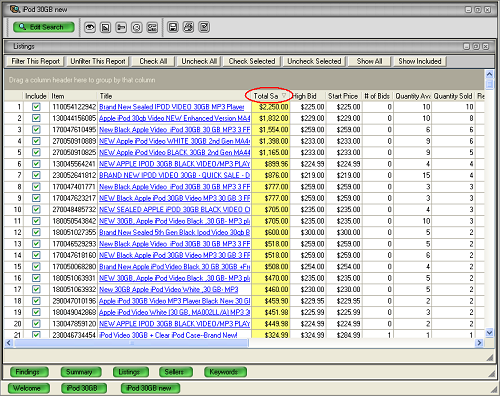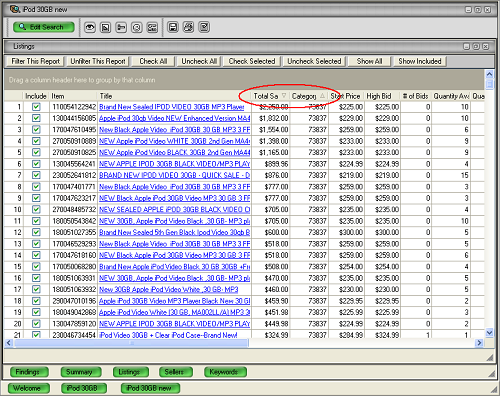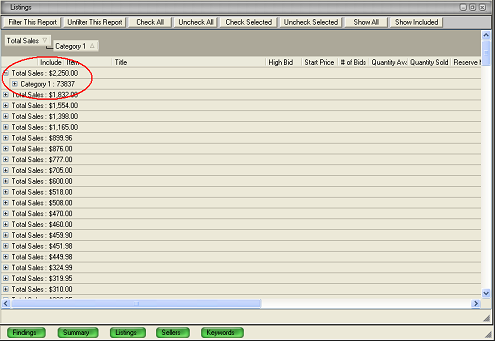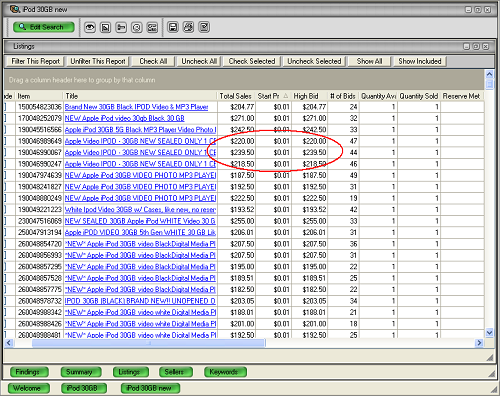 |
 |
 |
Lesson 6Choosing Effective Categories and Starting PricesHey there, eBay Executive! So I have to ask, are you wearing a suit now, or did you take my advice and stick with the "executive shorts?" You know, they make some pretty expensive shorts for executives now...but enough of that! Back to our iPod quest. A couple questions still remain: What category should I list my item in and what is a optimal starting price for my item? This is when your fishing skills will come into play. For example, if I am going fishing, I obviously want to catch that champion fish. But in order to catch the big fish (high bidder), I need to 1) be fishing in the right lake (category) and 2) have the right hook (starting price) for the fish I want to catch. The wrong lake means that the fish I want to catch won´t be looking for bait in that lake. The wrong size of hook means that it will be either too small, and the fish will steal my bait without taking the hook, or it will be too big, and the fish won´t pay attention to it. In other words, you need to list your item in the category that will give it the most attention. You also need to set the most appropriate starting price so the high-paying buyers will get hooked. Today I will teach you how to find the best category and start price for your auction. Introducing the Listings Window!In Lesson 3, we spent a little time in the Listings window, but now we are going to see what it can really do for us. Go ahead and open up our saved file, iPod 30GB. Click on
As I mentioned before, this window displays every auction included in our research results. The auctions are actually links that access the original closed auction on eBay.
This window also has many columns that can be viewed by scrolling to the right of the screen. To me, this window, along with the Keywords window, truly manifest the power of your Research Tool. In this window you can manipulate the data to tell you what you want it to. Huh? Okay, basically, you ask the questions and this window will give you the answers. Sorting the DataFirst let´s learn how to sort the data. I mentioned this briefly in an earlier lesson, but want to show you again here. Look at the Total Sales column. By clicking on the column heading, the data is sorted in ascending or descending order. (Notice which way the little arrow is pointing. That tells you which way the data is sorted.) You can sort this data by any column heading and compare that column to other columns. Listing in the Right CategoryListing in the right category is all about supply and demand. You want to get your product where the most people who want it will see it. Let´s go back to the example of my friend making $15 more per shirt if he closes it in the early morning hours. If there are only fifty polo shirt available at that time in that category, and there are 500 buyers bidding for the same shirts, your profits will go through the ceiling. Let´s figure out the best category for these iPods. Now that you have the data sorted by Total Sales, let´s compare that to another column. For this example, let´s compare it to the Category 1 column. To do this:
Now you can see which categories worked best, according to total sales. In our example, category 73837 is specifically for iPod 30GBs, and every listing in our research listed their iPod in the same category. However, other products sold on eBay may not have obvious categories; similar products may be sold under many different categories. This is why it´s important to research the best category for your product. You have to think of it this way—the auctions that make the most money receive the most attention from buyers. More buyers see the same item, which drives the bids higher than those on a product listed in a different category. There is one more way you can move the data to look at this from another angle. Remember, as an executive decision maker, you want to look at this from as many angles as you can. To do this:
To go back to the Listings window:
Setting Just the Right Starting PriceTo set that hook with the highest bidder, you need an effective start price. To find out what that price is, we will use some of the techniques we used to find the right category. But you may be asking yourself, "Why don´t you just give me the average starting price in the executive summary and save me the time?" Setting an effective starting price using data is an art form that cannot be taken lightly. Okay, it´s not that serious, but it is important. The point is, if you took the average start price for a specific product, you would have a range of start prices from $0.99 to $50 or even higher. That average will not give you the start prices that will give you the highest profit. You´re setting the size of your hook based upon the average of hook sizes and not upon the size of fish you want to catch. In order to get that start price, you need to compare the items with the highest ASP with the Start Price of each item. To do this:
For these iPods, the optimal start price is around $0.01, to get the highest profit, around $230.00 (in other words, the total sales minus the starting price). Though several of the iPods offered sold for up to thousands of dollars, I found that these listings either came with special offers or allowed customers to buy up to four iPods at a time. Be sure to click on the link to each auction to investigate exactly why it closed with the profit it did, particularly if it closed with a much higher ASP than the average listing. Now you can see why I said that setting an effective start price is an art form, just like selecting the right size hook to catch a fish. I´m sure you see items listed all the time that have a start price so high, that no one is willing to bid on it. On the other hand, some are set so low that they cannot create enough bids to get the price up where it needs to be. Assignment #6: Get ready to go fishing!Ready to go fishing? Research your own product or open up a saved report and have some fun moving the data around in the Listings window. Really, the angles that you can look at different scenarios are only limited by your imagination. Start by finding the best category to list your item in, then move on to finding the optimal starting price. After that, you´re on your own to make sound decisions as the executive of your auctions. Ahhhh, you GOTTA love it! Can you taste the success that´s coming your way? |
|||||


 When you are in the Listings window and find an item that sold particularly high, it´s a good idea to go to the original auction and find out what made the difference. Was it the pictures? Was it the product description? Did they use Auction Trust Network? Answering these questions can often increase your profits.
When you are in the Listings window and find an item that sold particularly high, it´s a good idea to go to the original auction and find out what made the difference. Was it the pictures? Was it the product description? Did they use Auction Trust Network? Answering these questions can often increase your profits.

